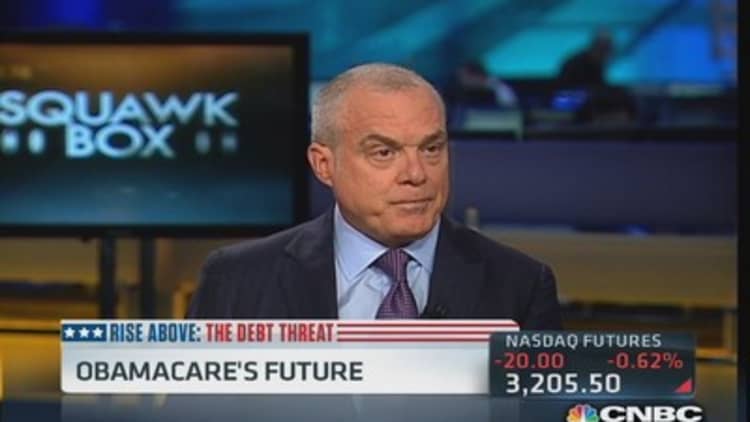Obamacare has a 99.6 percent rating—and not in a good way.
A paltry 36,000 people managed to enroll in the federal online health-insurance marketplace in its first, software-glitch-ridden week of operation, a grim new analysis found Wednesday.
That's "far fewer than one percent of all visitors to HealthCare.gov" for the week ended Oct. 5, wrote Matt Pace, managing director of research firm Millward Brown Digital, on a blog post entitled "A Bleak First Week."
In fact, the firm found 99.6 percent of HealthCare.gov's visitors left before enrolling in coverage, a sobering statistic given the Obama administration's goal of signing up 7 million people on new government-run health exchanges by 2014.
HealthCare.gov is offering a menu of health insurance plan options to residents of the 36 states that are not operating their own health exchanges. Previously released data from the states running their own exchanges—a number of which are struggling with tech problems of their own—also suggests a very low level of enrollment so far.
"Unfortunately, what started as a fire hose of interest, resulted in only a small trickle of actual health-care enrollments," Pace wrote.
The federal government disputed Millward Brown Digital's findings, with an official calling them "inaccurate."
(Read more: Aetna CEO saw Obamacare tech tornado coming)
But the findings mirror reports that insurance companies are seeing very low enrollment from HealthCare.gov visitors. And experts have said the website has just about three weeks or so to address its myriad tech problems, or face the prospect of significantly hampering enrollment.

Millward Brown—which tracks the online activity of 2 million Americans, or 1 percent of all Internet users— found that 9.47 million people visited HealthCare.gov in the week ended Oct. 5. Enrollment began Oct. 1.
Federal officials have claimed that influx of millions of visitors overwhelmed the marketplace's servers, and led to the interminable waits that people experienced when visiting. But Pace pointed out that the 9.47 million visitors "is roughly equivalent to the daily traffic on Target.com."
Just a fraction of those visitors, 3.72 million, tried to register accounts on Healthcare.gov, according to Millward Brown, and just 1 million or so of those people completed registration.
(Read more: Overhauling Obamacare)
Nearly 200,000 began the enrollment process—moving to actually select and pay for an insurance plan—but just 36,000 completed enrollment, the analysis found. That's about 1 percent of the people who tried to register accounts.
"It's not a surprise that news media organizations are having a difficult time finding anyone who has actually enrolled for health insurance, or that the Obama administration has been reluctant to share enrollment statistics with the public," Pace wrote.
When asked about Millward Brown's analysis, a Health and Human Services Department spokesman reiterated that HealthCare.gov is not releasing any enrollment data until next month.
"HealthCare.gov received 14.6 million unique visits in the first 11 days, showing intense demand for quality, affordable health insurance," said HHS spokeswoman Joanne Peters, whose department operates HealthCare.gov. "While traffic is down somewhat from its peak on Day One, it remains high as Americans continue to seek to learn more about their new coverage options."
Under the Affordable Care Act, nearly all Americans must have health insurance in mid-February or so, or face a tax penalty.
(Read more: Teasing Obamacare Czar: "Daily Show" zings Sebelius)
The bulk of Americans have health insurance through their employer's plan, or from the government-run Medicare and Medicaid programs, but to offer affordable coverage to the 50 million or so people who don't, the ACA mandated the creation of health marketplaces, or exchanges, where insurers offer competing plans at different price levels.
Many of those people will qualify for government subsidies to offset the cost of their premiums as well as out-of-pocket charges.
In order to keep prices on those plans affordable, Obamacare proponents are pushing to get 7 million or so people enrolled by 2014, and in particular are hoping to get nearly 3 million young adults to enroll. Those younger people are seen as crucial, because their premiums will help offset the costs of benefits paid out to older enrollees, who as a group have more health problems.
For the insurance to kick in by Jan. 1, people who sign up through the exchange must enroll and begin paying for coverage by Dec. 15. However, open enrollment lasts through March 31.
—By CNBC's Dan Mangan. Follow him on Twitter @_DanMangan.


